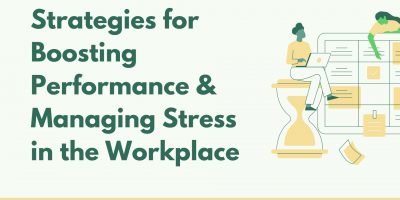
Hire & Keep Top Talent with High-Performance Management
In an ever-changing global economy, how can employers create a workplace culture that supports and encourages high levels of employee productivity, satisfaction, and retention?

The way a company manages employee performance makes a significant impact on its bottom line. Nothing crushes company culture like lousy performance management.
In today’s ecosystem, traditional performance reviews are not enough to keep and maintain talent. They are prone to subjectivity and errors, yet highly time-consuming. Often, they focus on the wrong outcomes. Fortunately,the HR industry has focused on developing revolutionary software solutions that help managers make the proper assessment.
Performance management systems are built to solve each of these problems and are based on extensive research. In other words, they are different from old-school reviewing; and that is intentional.
Performance management systems today are built to be simple. They cut the time-consuming reviewing process by providing feedback to managers constantly. According to research done from TruQu, 76% of all workers expect feedback at least once a month. Moreover, workers expect that the collected data is accessible at any moment, and on some platforms, it is even available on mobile devices.
Most performance systems today look like social media platforms. They are user-friendly and have the ability to elevate engagement for more detailed results. Every employee has a personal profile, and most of the data like employees’ profiles and feedback on accomplishments, is accessible to anyone in the company. Of course, the confidential data stays classified and visible only to managers.
However, when a company chooses to buy a performance management system, it should always consult with the vendor to see if it provides a product that fulfills their needs and can be utilized in the long run. Just to be on the safe side, it is crucial to do research before buying and also explain to the vendor the extent of needs the company has. In the end, certain features are not included in all products.
Performance management systems are different from performance support systems, which help employees better adopt digital solutions.
Employees can use this feature to assess their own performance based on previously set parameters by their managers. Performance management systems features predetermine questions that are specifically designed to limit subjectivity and prompt, actionable feedback.
The questions make managers more objective, informed, and focused on improving performance instead of getting hung up on whether someone deserves a raise. If the managers need insights specifics for their organization, they can add more questions at any time. This feature can be set to occur annually, semiannually, or quarterly.
Peer feedback gives colleagues a chance to provide a firsthand observation of a person’s work behavior and performance. Spending 8 hours in an office sitting side by side gives employees plenty of time to form an opinion about each other. A simplified but regular evaluation saves time and gives people chance to implement changes while the feedback is relevant and top of mind.
With peer-assessments every person can reflect on their performance and encourage regular conversations with their managers to ensure both sides are on the same page.
In each cycle, a manager can assign different peers to give back feedback to each other. This method provides a complete perspective of how the employee is doing. The manager can use the information to help the team improve and grow.

Each employee must understand their own strengths and development areas and deliberately plan their career trajectory.
Hence, the individual development plan is an invaluable tool for HR professionals because it helps employees improve their performance, sharpen their strengths and reach their career goals.
The plan is created by the employee and the manager together, and each plan needs to be result-oriented, not activity-focused. To have the proper focus for the IDP, each employee needs to have a regular capabilities assessment from the leadership layer they belong to. This assessment will help them understand what is required of them to perform with excellence and deliver the annual objectives.
The main goal for each company is to create leaders who will:
Employers need to pay attention to talented employees to empower them to strive for more and drive their careers.
Highly gifted employees are self-confident yet humble, committed to achieving their goals. They desire constant learning, acting as role-models to others by respecting and trusting the organization.
Any performance management software must have the capability to generate dynamic goals. It serves as the framework for evaluating employee performance inside the company.
Managers and HR will not be able to adequately evaluate an employee’s performance if goals are not properly set. However, if goal planning is done correctly, it can help promote employee engagement in a way that benefits both the employee and the organization.
After the goals are set, progress can be reviewed simultaneously, allowing managers to continuously coach and mentor. Managers can align any plan towards their own to ensure everyone is working on the same outcome.
In fact, in companies where employees’ ambitions are related to business interests, 46% of respondents say performance management is efficient. Not to mention that great motivation comes from being able to monitor and record their performance against set goals.
Reporting and analytics of data can help summarize and make sense of data gathered about employee’s performance. This function maximizes the benefits of the performance management system using visual representation.
The feature can be useful for enabling employees to improve their performance over time. It allows managers to track an employee’s performance throughout the whole year, making annual assessments considerably more efficient and straightforward.
Here are some examples of the four most popular reports in performance management software:
They all give an overall complete representation of what is going on in real-time and long-term as well. Therefore, it pinpoints week links and assesses if the company is going in the right direction.
While tracking and measuring employee performance may not be the number one business goal, it directly impacts the company culture. And good company culture is essential to bringing and obtaining the A players in the industry. That is how performance management translates into profit.
Browse our curated list of vendors to find the best solution for your needs.
Subscribe to our newsletter for the latest trends, expert tips, and workplace insights!

In an ever-changing global economy, how can employers create a workplace culture that supports and encourages high levels of employee productivity, satisfaction, and retention?

Unlock the strategies to drive your organization toward peak productivity and success through effective performance management practices.

Learn practical techniques for enhancing productivity and effectively managing stress in the dynamic workplace environment, ensuring a balanced and thriving workforce.

Discover how, if done correctly, effective performance management can benefit both employers and employees.
Used by most of the top employee benefits consultants in the US, Shortlister is where you can find, research and select HR and benefits vendors for your clients.
Shortlister helps you reach your ideal prospects. Claim your free account to control your message and receive employer, consultant and health plan leads.